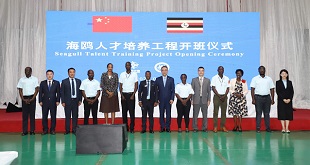
By Maya Prabhu
Uganda is one of the world’s top banana-growing countries, producing as many as 10 million tonnes of the fruit each year, but the banana market is under-exploited. Its potential to act as a bastion of food-security and create lucrative openings for ambitious entrepreneurs requires innovation in the way the fruit is produced, marketed and consumed.
Currently, African bananas make up only 4% of the bananas sold in the European Union, the world’s largest banana importer, and this figure is set to decrease further as the EU will imminently abandon its reduced import tax for African bananas. But bananas for export are not the first priority to Fen Beed, researcher at the International Institute of Tropical Agriculture (IITA). Internal markets should be strengthened first, he says, and to do that, a greater synergy between all the players in the banana game is crucial, especially since banana production in Uganda has actually been decreasing over the last few years.
Beed stresses the importance of an overhaul of the entire value chain behind the banana market:”too many people are affected to let it stay inefficient” he says. In 2008, his NGO organised the first Pan African Banana Conference which brought together researchers, marketing experts, farmer organisations and others engaged in banana production and sale, in an effort to reform the faulty ‘business as usual’ approach to the Sub-Saharan banana.
“We want to make the banana an economic driver,” says Beed. The problems of disease control, water and soil nutrient management which account for the recent trend of decline in banana production, could be combated by working towards an improved information flow between the various links in this chain.
Enshrined in Ugandan tradition, the banana is boiled and steamed to make matooke¸ a crucial staple food; it is drunk as juice, which is fermented for beer and refined further to make waragi spirit. Banana fibre is used to make anything from furniture to jewellery, and the plant’s dried leaves have even been donned by supporters to signify their endorsement of the continued rule of the NRM party.

But tradition does not preclude progress. Dr. William Kyamuhangire of the Food Science and Technology Department at Makerere University heads up a team researching the commercial production of banana juice, a product for which he is convinced there is large and, as yet, unsatisfied market.
The majority of Ugandans will have tasted the drink as children, he told the Independent, and expect to find it bottled on the supermarket shelves of urban centres but are disappointed by this gap in the market. His research has refined the traditional manual method of juicing into a patented mechanized process, as well as introducing an indoor room-ripening procedure for the special juice banana. Currently, Dr. Kamughangire’s team is preparing means to operate the juice extraction and packaging processes in a single location, to test the economic viability of the juice’s production.
Another project, headed up by the Presidential Initiative on Banana Industrial Development (PIBID) will see the construction of a banana-flour or ‘tooke flour’ factory in Bushenyi. PIBID expect the mill’s completion this December. At this point, their current, smaller scale production operation will be expanded: the design capacity of the factory allows for the daily production of 5000kg of tooke-flour.
The Tooke Project, like Dr. Kyamuhangire’s research, represents an opportunity for future investment in all stages along the value chain: in production, processing, and marketing. Two types of flour are produced: raw flour, which can be combined with or substituted for grain flours in baking and is already being used in the production of ‘tooke biscuits,’ as well as an ‘instant’ variety, which can be used in cooking to quickly create a matooke substitute and to thicken soups and stews.
Martin Ssali, Associate Assistant in PIBID’s marketing department says, ‘the response [to tooke flour] both locally and internationally has been wonderful,’ with orders issuing from as far abroad as Germany, the US and Malaysia, as well as from other African countries like Kenya and South Africa.
Beyond opening up business opportunities, innovations in Uganda’s banana market could have important implications for food security and farming fortunes. Dr. Joseph Bahati, Deputy Director of PIBID sees tooke flour as a potential solution to problems associated with the short shelf-life of the perishable fresh banana, minimising spoilage and waste and allowing for long-distance transport of the food product. Buffer stocks of the flour also have the potential to level out fluctuations in banana prices over changes in weather cycles.
Beed, Bahati and Kyamuhangire all emphasise the importance of strengthening links and increasing technical support to farmers, reducing of the costs and risks of production while helping them to increase their output, earnings and influence on the market. Jim Lorenzen, a programme leader at IITA, estimates that effective irrigation alone could increase banana production by at least 50 per cent.
With gaps in the market and enormous room for improvement in the banana production chain, in Uganda, the banana is a crop with huge and as yet, unrealised, potential. But researchers have warned that effecting substantive change in the banana market will require a considerable commitment on the part of investors and current stakeholders.
 The Independent Uganda: You get the Truth we Pay the Price
The Independent Uganda: You get the Truth we Pay the Price


